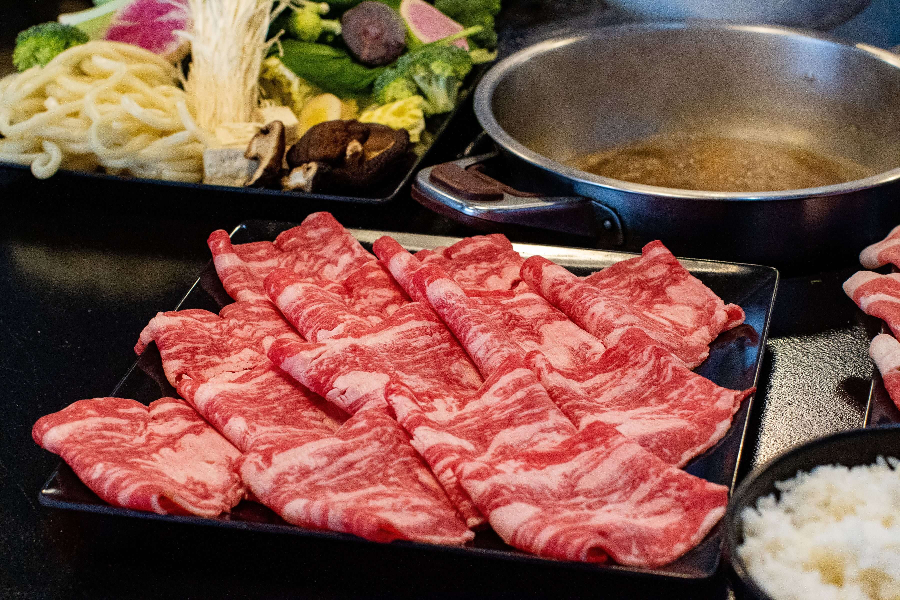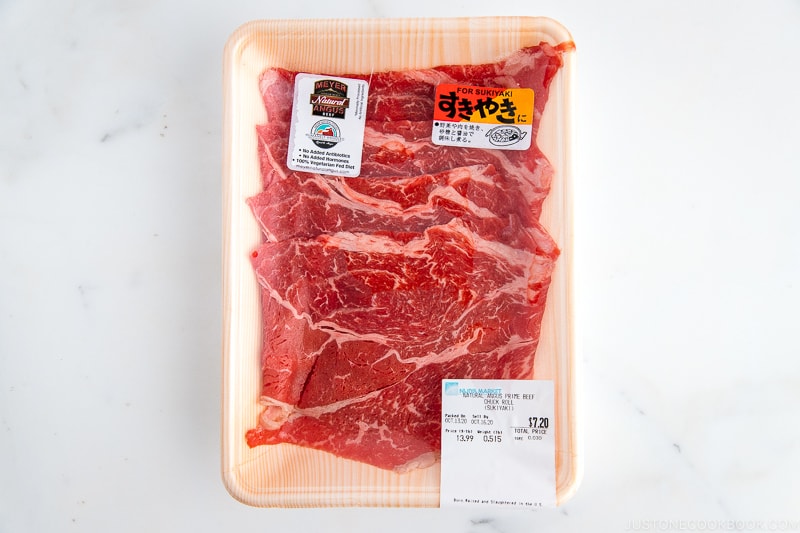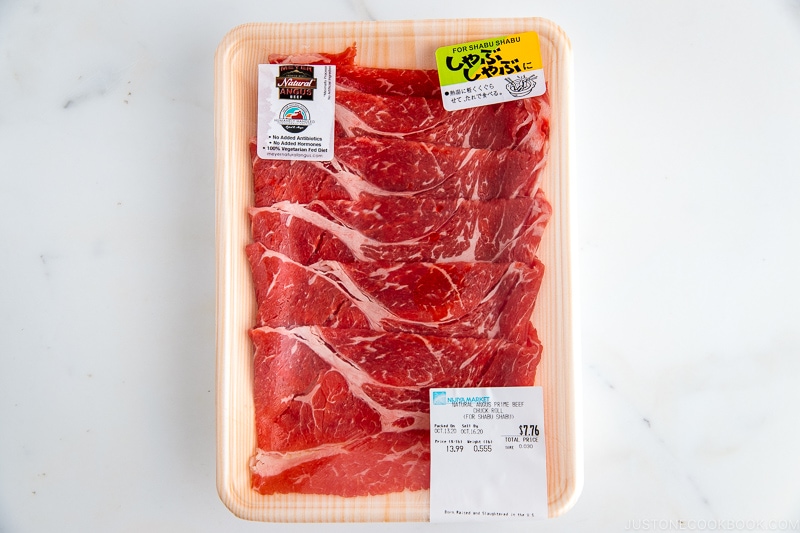Many Japanese dishes require thinly sliced meat (beef and pork). Here are the most common types used in Japanese cooking.
Shabu shabu, the quintessential hot pot dish hailing from Japan, beckons beef lovers with its visually stunning thinly sliced raw beef and promises of a sublime gastronomic experience. However crafting the perfect shabu shabu requires selecting the ideal cut of beef to fully unlock its potential. This comprehensive guide unravels the mystery exploring the most suitable beef cuts to elevate your shabu shabu to new heights of enjoyment.
The Allure of Shabu Shabu
Before delving into beef cuts let us first understand shabu shabu’s origins and allure. Shabu shabu originated in Japan where ‘shabu shabu’ imitates the sound of swishing thin slices of meat in a hot broth. This elegant cooking technique epitomizes the refined simplicity of Japanese cuisine.
To make shabu shabu thin raw slices of meat and vegetables are briefly swished in a steaming broth until just cooked. The cooked ingredients are then dipped in sauces before savoring. The dish is designed for sharing and usually cooked right at the dining table in a communal pot evoking warmth and togetherness.
While traditionally made with beef, shabu shabu sometimes incorporates pork, chicken, seafood or vegetarian ingredients. However, beef remains the most popular choice, prized for its succulence and rich umami flavors that infuse the broth.
The Importance of Selecting the Right Cut
When crafting exemplary shabu shabu, choosing the appropriate cut of beef is paramount. The meat must be thinly slicable, tender and flavorful. Tough cuts require long cooking times, compromising the delicate textures and pristine flavors that define shabu shabu.
Leanness is also crucial, as excess marbling leads to an overly greasy broth. The beef should ideally feature moderate marbling to provide sufficient fat for flavor without overpowering the broth.
With so much hinging on the beef cut, let’s explore some of the best options for your shabu shabu.
Ribeye – The Traditional Favorite
For traditionalists, ribeye remains the undisputed champion for shabu shabu. With its perfect marbling and supple texture, ribeye was born to shine in hot pots. When thinly sliced, the ribeye’s marbling melts into the broth, imbuing it with rich depth sans greasiness. The meat also cooks quickly, absorbing the umami flavors of the broth beautifully.
While pricier than other cuts, the sublime experience ribeye delivers is well worth the splurge for beef aficionados. For the ultimate indulgence, splurge on premium Wagyu ribeye. With its extensive marbling and velvety texture, Wagyu ribeye will transport your taste buds to beef nirvana.
Tenderloin – The Luxurious Alternative
For special occasions or when cost is no concern, tenderloin makes a luxurious alternative to ribeye. As the most tender cut available, tenderloin provides melt-in-the-mouth sensations unmatched by other cuts. When thinly sliced, it cooks lightning fast while absorbing flavors optimally.
With less marbling than ribeye, tenderloin delivers a cleaner, more refined broth. Its milder flavor can also appeal if you want the vegetables and dipping sauces to shine. For lavish occasions, tenderloin is a beef lover’s dream.
Top Sirloin – A Budget-Friendly Option
For those seeking a more economical option, top sirloin offers an admirable balance of marbling, tenderness and affordability. It is significantly less expensive than premium cuts but still delivers satisfyingly on texture and flavor.
With moderate marbling, top sirloin produces a light, clean broth while avoiding a greasy mouthfeel. Sliced thinly against the grain, top sirloin cooks up tender while offering a mildly beefy flavor. Overall, it’s a solid budget option for everyday shabu shabu enjoyment.
Brisket – For Intense Beefiness
While requiring longer cooking, brisket shines in shabu shabu with its intense beefiness. Brisket contains high levels of collagen that must be broken down through slow cooking. But this extended cooking extracts incredible richness and body for the broth.
The meat itself also absorbs the broth’s flavors optimally. Just be sure to slice the brisket across the grain as thinly as possible to mitigate its inherently fibrous texture. With its beefy punch and indulgent broth, brisket makes a wonderful change of pace from pricier cuts.
Other Cuts to Consider
Beyond these top contenders, other cuts can also work well:
- Chuck roll – Similar marbling to ribeye but cheaper. Requires very thin slicing.
- Flank steak – Very lean but flavorful. Slice across the prominent grain.
- Skirt steak – Intense beefiness like brisket. Must be sliced thinly against the grain.
- Short ribs – Must be thinly sliced but produces a lip-smacking broth.
Key Tips for Selecting Shabu Shabu Beef
Keep these tips in mind when selecting beef for optimal shabu shabu enjoyment:
-
Focus on tenderness – Tough cuts with thick fibers just don’t work. Opt for tender cuts like ribeye, tenderloin and sirloin.
-
Moderate marbling is key – Some fat provides flavor but avoid excessive marbling which overwhelms the broth.
-
Slice across the grain – This disrupts the meat fibers so they cook up tender instead of stringy.
-
Thin is best – Slice meat as thinly as possible so it cooks fast while absorbing broth flavors.
-
Choose freshness – Pick the freshest beef available for best flavor, texture and food safety.
Take Your Shabu Shabu to New Heights
While shabu shabu is seemingly simple, the correct beef cut is integral to creating the ultimate experience. For time-honored indulgence, splurge on marbled ribeye or tenderloin. Or opt for top sirloin or brisket to stay budget-friendly while still enjoying tasty results. Remember to slice the beef paper-thin across the grain for ideal textures.
With the perfect cut of beef and steaming hot broth, it’s time to gather friends and dive into the communal warmth and beefy decadence of shabu shabu – a Japanese culinary gift sure to satisfy seasoned beef lovers and newcomers alike.

Thinly Sliced Beef Chuck/Ribeye for Sukiyaki

For Sukiyaki and other beef recipes, this cut of beef is used. It is a little thicker than the one used for Shabu Shabu.
Different Types of Thinly Sliced Meats

Slice Meat Thinly With This Easy Trick | Mad Genius Tips | Food & Wine
FAQ
What kind of beef is used in shabu shabu?
Which part of beef is good for hotpot?
What cut of beef is used for sukiyaki?
What is a substitute for shabu shabu beef?
What kind of meat is used in shabu-shabu?
In shabu-shabu, beef is the type of meat used, particularly in high-end Japanese restaurants. Quick refresher — shabu-shabu is a Japanese hot pot dish with a kombu (dried kelp) and dashi (Japanese soup stock) base. There are various meats to choose from (pork, chicken, or lamb), but beef is the preferred option.
How much meat is in a shabu shaku?
The standard portion of shabu-shabu meat for an adult male is 200-300 grams, for females it is 150-200 grams, and for elementary and middle school students and the elderly it is 100-150 grams. There are five preferred cuts of beef for shabu-shabu, including the chuck eye roll, which is relatively low in fat and well balanced with lean meat.
Should you use marbled beef in Shabu-Shabu?
According to Pogogi, marbled beef is the number one choice for Shabu-Shabu, although some restaurants may offer leaner cuts. KitchenBaroness suggests buying enough beef sirloin for each person, ensuring there are at least 8.8 ounces (250 grams) per person.
What is a good substitute for beef shabu?
Pork Belly: Thinly sliced pork belly offers a rich and savory flavor. Seafood: Shrimp, scallops, and fish can be added to the shabu shabu for a lighter, seafood-inspired experience. Chicken: Chicken breast or thigh slices provide a lean and flavorful alternative to beef.
